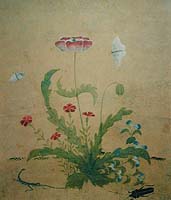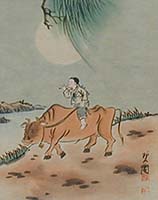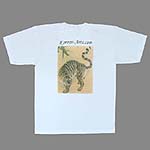If the images do
not appear or you cannot see this email, click here to see the online
version:
http://www.korean-arts.com/newsletters/080805.htm
The
Korean-Arts
Newsletter for August 5, 2008
New Items
Traditional Prints
On Sale
Free T-shirts
About Korea: Korean Paintings
Subscribing-Unsubscribing
 New Items
New Items
Traditional Prints
|
|
Traditional prints of two famous Korean painters from the Chosun Dynasty are now available; Shin Sa-im-dang (1512-1559) a renowned female painter of the Chosun Dynasty, Shin Sa-im-dang is one of the most famous artists in Korean history and is known for her depictions of plants and animals such as 'Poppy' shown at left. We also have ten prints by Kim Hong-do (1745-1815?), arguably the most famous Korean painter. his depictions of scenes of daily life from the Chosun Dynasty are renowned for their artistic value as well as the light they shed on the daily lives of citizens of the time. The Chosun Dynasty saw the decline of the influence of the strong Buddhist culture and the emergence of the Silhak, or practical learning, movement which emphasized understanding based on actual observance and thus ushered in works of realistically depicting plants and animals such as those by Shin Sa-im-dang, and genre paintings, or scenes of ordinary people engaged in common activities such as those portrayed by Kim Hong-do. All our traditional prints are mounted on a white matte frame. See our all our traditional prints here, and all our new items here.
 On
Sale
On
Sale
In addition to plants and genre paintings, many other types of paintings flourished during the Chosun Dynasty. Paintings from the Chosun Dysnasty can be roughly divided into five different styles; landscape, genre, minhwa, four gracious plants, and portraits. We currently have representative scroll paintings from most of those styles for sale including three genre scrolls, such as 'Boy on Ox' at right, two minhwa tiger scrolls, four styles of the four gracious plant scrolls, and two additional calligraphy scrolls. Learn more about the different styles of Korean painting in our article below "About Korean Paintings". See all our sale items here. or all our paintings here.
 Free T-shirts
Free T-shirts
We love art and like to show it on our company t-shirts; consequently they have become so popular we are now offering them free until the end of August and just in time for summer.
We are giving a free t-shirt ($15 value) for every order of $100 or more (total cost including shipping) from August 10 through August 31 2008 (Korea time). To get your t-shirt simply fill out the t-shirt ordering form that will appear after you submit your order of over $100. See details here.
The back features a
Tiger and Bamboo painting from the late
Chosun Dynasty
by Kim Hongdo (1745-1815?) and Im Huji (b. 1763) and the front
has the "I
 ART" logo. Tigers play an important role in Korean art and history and
symbolize a guardian and charm, and their likenesses, either on a painting
on the wall, or on the back of your t-shirt, are thought to act as guardians to the owner. And
they look really cool too! Our shirts are made from 30
thread count, heavy weight, 100% cotton, and like all our arts, are made in Korea.
See our T-shirts here.
ART" logo. Tigers play an important role in Korean art and history and
symbolize a guardian and charm, and their likenesses, either on a painting
on the wall, or on the back of your t-shirt, are thought to act as guardians to the owner. And
they look really cool too! Our shirts are made from 30
thread count, heavy weight, 100% cotton, and like all our arts, are made in Korea.
See our T-shirts here.
|
Subscribing-Unsubscribing
We
at Korean-Arts appreciate your patronage and do not wish to send unsolicited
mail. We send our newsletter once to each new customer, and every other
month or so* to continued subscribers. If you would like to be removed from
our mailing list for any reason, click on the link below and send the new
email that appears.
Please unsubscribe me from your mailing list.
Should a new email message not appear, reply to this email with the word
“UNSUBSCRIBE” in the subject line.



